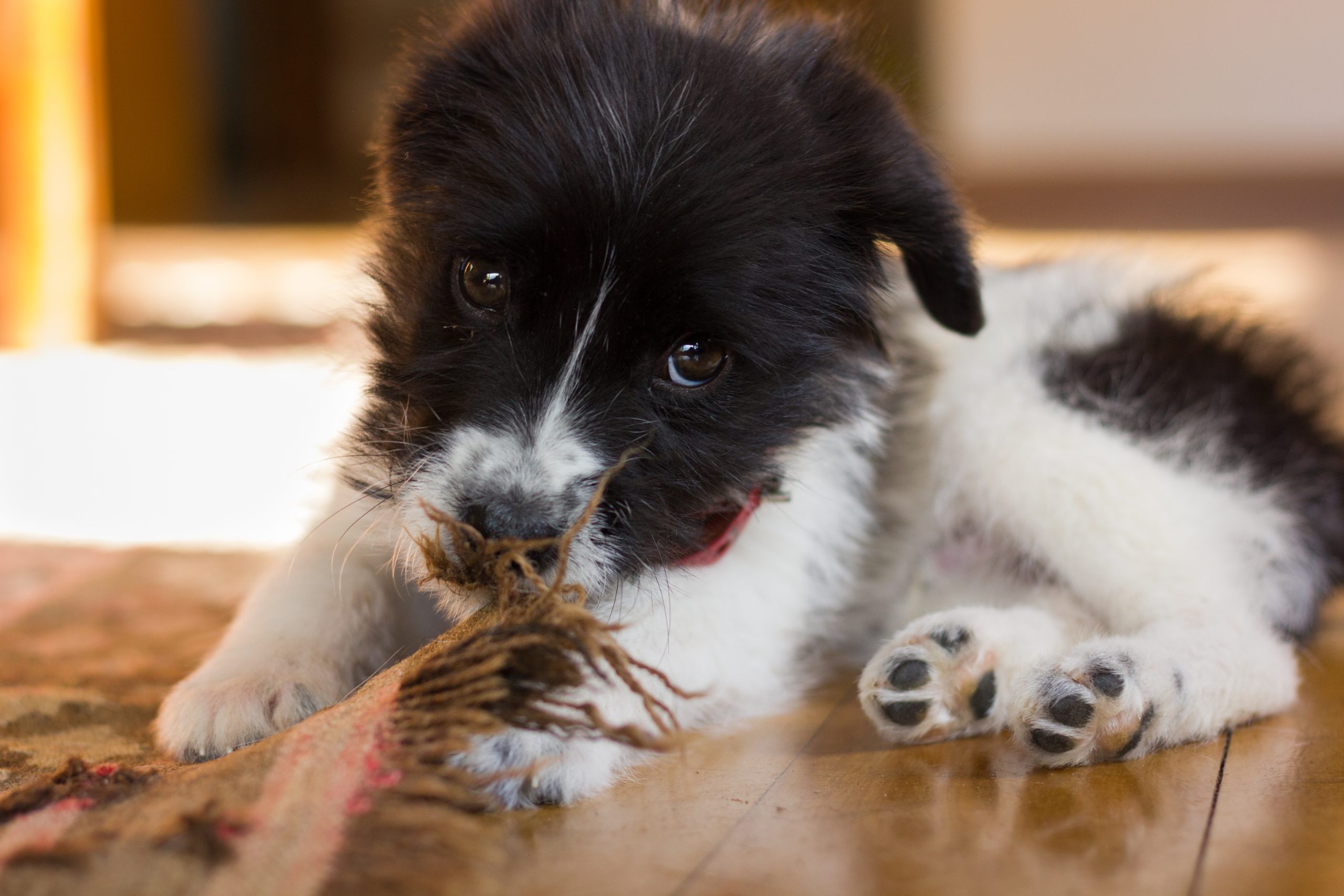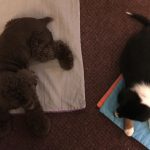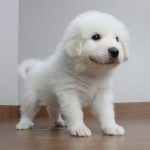Puppy Chewing: What to Do?
When your house becomes a chew toy…
Puppies chew things. And more things. And take a break to test their teeth on your hand. Then go back to chew another thing:
Gramps’ antique parlor chair…
Little Jimmy’s train set…
Your favorite shoes, with your feet still in them!
Our first reaction is usually to want to Make! It! Stop!
It’s normal and natural for our puppies and dogs to chew, though, and even beneficial, so how to protect our favorite things, while meeting our puppy’s needs?
When working with a problem behavior the preferred approach is to:
- Look for the underlying causes so that we can address our puppy’s needs in a more productive way;
- Manage the environment to prevent practicing the undesirable behavior;
- Train an incompatible alternative—a behavior that we like.
UNDERLYING CAUSES
Puppies and dogs chew for a variety of reasons, including:
Teething
For puppies, chewing relieves the discomfort of teething. It also helps strengthen jaws and keep teeth clean in puppies and older dogs.
Predatory behavior
As predators it’s normal for our dogs to use teeth and jaws as if to kill and eat prey. Although we provide our dogs’ meals, these intrinsic behaviors are natural. Providing appropriate outlets can lead to a happier, more well-balanced dog.
Anxiety
Is your puppy worried? Chewing can be an outlet for anxiety or stress. Sources of stress could include worries when you leave, not having a “hands off” zone in a home with active children, or even a sore muscle from rambunctious play.
Boredom
Nothing to do and your people are away? How about seeing what the couch tastes like? As with many human children, one of the ways that puppies explore their world is with their mouths. Providing mental exercise and games can alleviate this.
MANAGING THE ENVIRONMENT
In management we adjust our puppies’ environment to make the behaviors we like more probable, and to prevent the opportunity to practice the behaviors we don’t want to encourage. This involves planning our puppies’ living area and its contents.
Prevent
Create a safe play area using baby gates and exercise pens to prevent access to things you don’t want the puppy to chew. Be sure that the puppy’s safe space doesn’t contain any forbidden objects, especially hazardous items such as power cords, computer cables, houseplants, cleaning chemicals, Legos, etc.
Provide
Place a number of suitable chewing items in the puppy’s play area, and be ready to give one to your puppy any time she shows toothy interest in something unsuitable. Keep a number of appropriate items within your reach if she is not in her play area so that you can provide them immediately as a suitable alternative.
Interrupt
Tempting as it is to yell a sharp “no!” to stop your puppy as he is nibbling your elegant carpet, it’s just as effective to teach a happy “interrupt” sound, and a happy interrupt is less likely to scare your puppy or damage the trust that’s growing between you. I like “oops” or “uh-oh”, or even “not yours”, as it’s hard to sound cranky when saying them. The moment your puppy stops chewing the family treasure, begin play with a favorite toy, or feed a treat, and move your puppy away from the chewing temptation.
Manage for a Growing Puppy
As your puppy grows you will want to gradually expand his safe area. At this point you can use your exercise pens to surround tempting items of furniture, preventing his being able to chew on them, at the same time that you help him learn to make good choices with a bit more freedom.
TRAINING INCOMPATIBLE ALTERNATIVES
These are several behaviors that I find particularly helpful in moving a puppy away from chewing temptations, such as Drop or Come, but probably the most useful is the Happy Interrupt.
Happy Interrupt
Teach your puppy to look back at you when you ask.
- Prepare by having low-value treats to toss, and higher-value treats for rewards.
- In a low-distraction environment, toss a low-value treat a short distance to move your puppy away from you. Just as she is finishing the treat, say your interrupt word (mine is “Not Yours!”) in a happy voice, and as she begins to turn her head to you, say “yes” and treat from your hand with the higher-value treat.
- As she finishes up her reward, toss another low-value treat to move her away, say your interrupt cue, say “yes” as she turns her head to you, and feed from your hand with the higher-value treat as before.
- Repeat, increasing the distance that you toss the low-value treat very gradually as long as she is excited by the game.
- Increase the difficulty gradually, such as placing a mildly interesting object on the floor. Say your cue, and as she turns her head away from the object, say “yes” and feed from your hand or between your feet.
- When you start training in a new location, or with a more challenging object on the floor, decrease your distance from her and build up distance again gradually.
TROUBLESHOOTING AND TIPS
My Puppy Doesn’t Play with His Toys
A toy just lying on the floor may not hold much interest for your puppy, and simply handing it to him might not increase his interest. Build interest in the toy by playing with it with your puppy. A game of “Tug” may be just the ticket.
If you’re offering a chew toy but your puppy isn’t very interested, try smearing a tiny bit of peanut butter or cream cheese on the toy to add scent and taste to entice your puppy.
When Puppy Persists
Sometimes a puppy will persist in chewing a certain item, even with suitable alternatives frequently and generously provided. Your first step should be to prevent access when not training, and to train the Happy Interrupt such that your puppy is excited to play. If all else fails, there are several commercial ill-tasting sprays intended to make the thing your puppy is chewing taste bad. As with anything your dog might ingest we recommend consulting with your vet before using it.
“It’s Not Working!”
Often we’ll get a great response when we introduce a new behavior, but the next time we cue a “Not Yours” or “Oops” it’s as if our puppy doesn’t know the behavior. This is a common challenge, but it gives us great information! It tells us that we need to go back a few training steps to where our puppy can be successful, and gradually increase difficulty from there.
Exercise Your Puppy’s Brain
Mental exercise is as important for your puppy’s behavioral health as is physical exercise. There are a number of puzzles, games, and food-dispensing toys, and you can create your own by bringing a few household items together too. Check out our blog on mental exercise and enrichment.
Here are links to some of the items mentioned in the blog:
Exercise Pens
There are a number of good exercise pens available. We’ve been happy with our ex-pens from Midwest Homes.
Our Favorite Chew Toys
Himal Dog Chew Made of Yak’s milk, cow’s milk, lime juice and a little salt, I use this hard chew if the dog or puppy is drawn to wood, hairbrushes, or other hard items to chew. If your puppy is a power chewer watch to be sure it doesn’t splinter, and as with anything your puppy ingests, check with your vet.
Kong Classic This traditional pear-shaped toy is great for stuffing with food for your puppy to lick out. Licking is a calming behavior.
Planet Dog dense rubber bone This, or another dense rubber bone, can be a good choice to replace your shoes, or arm, as a chewing target.
West Paw Zogoflex Qwizl This toy brings together some great features. It can be stuffed with food, but is also roughly bone shaped.
Curly Bully Stick This bully stick is digestible, and a favorite in our house! As with anything your puppy ingests, check with your vet.
Bitter Sprays
These sprays add an unpleasant flavor to objects that your puppy is currently chewing. Note that some puppies LIKE these flavors, so your mileage may vary! Do check with your vet before using.




